Cargando...
Recursos educativos
-
Nivel educativo
-
Competencias
-
Tipología
-
Idioma
-
Tipo de medio
-
Tipo de actividad
-
Destinatarios
-
Tipo de audiencia
-
Creador
-

End-of-unit activities - The Plant Kingdom
EduBook Organización
- 2634 visitas
Plants are one of the most visible elements in the countryside. They provide colour, greenery and beauty where they live and flourish. Plants are not only decorative, but also essential life-giving…
-

Introduction - The Plant Kingdom
EduBook Organización
- 2620 visitas
Plants are one of the most visible elements in the countryside. They provide colour, greenery and beauty where they live and flourish. Plants are not only decorative, but also essential life-giving…
-

Animal reproduction
EduBook Organización
- 14191 visitas
Reproduction is the only vital function that is not needed to keep an individual alive. It ensures the continuation of the species. Although sexual reproduction is a universal characteristic of animals,…
-

The Animal Kingdom (I). Invertebrates
EduBook Organización
- 13874 visitas
Today our planet is home to a great variety of organisms. This is the result of an evolutionary process that began some 3.5 billion years ago. Invertebrates are a very diverse group of animals that do…
-

Introduction
EduBook Organización
- 7258 visitas
1. From biomolecules to organisms The molecules that make up living things, biomolecules, join together to form large molecules called macromolecules. The next level of complexity is the cell, which is…
-

Introduction - Animal reproduction
EduBook Organización
- 1 lo usan
- 4728 visitas
Reproduction is the only vital function that is not needed to keep an individual alive. It ensures the continuation of the species. Although sexual reproduction is a universal characteristic of animals,…
-

Introduction - The Animal Kingdom (I). Invertebrates
EduBook Organización
- 1 lo usan
- 4658 visitas
Today our planet is home to a great variety of organisms. This is the result of an evolutionary process that began some 3.5 billion years ago. Invertebrates are a very diverse group of animals that do…
-

Characteristics of living things
EduBook Organización
- 4878 visitas
Living things (or organisms) are different from non-living things because: They are active: they do things that help them to survive and reproduce. They are sensitive to their surroundings. Vital…
-

Investigate - Animal reproduction
EduBook Organización
- 1 lo usan
- 4570 visitas
Reproduction is the only vital function that is not needed to keep an individual alive. It ensures the continuation of the species. Although sexual reproduction is a universal characteristic of animals,…
-

Summaries - Living things
EduBook Organización
- 4737 visitas
1. Characteristics of living things Living things or organisms are different from non-living things because: They are active: they do things that help them to survive and reproduce. They are sensitiveto…
Te estamos redirigiendo a la ficha del libro...













